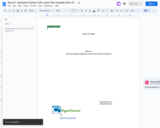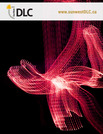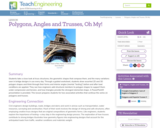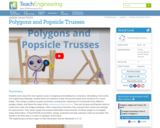
Great, short, engaging videos to explain all things physics to learners of all ages. Everything from Covid-19 to gravity to parallel universes!
- Subject:
- Physics
- Science
- Material Type:
- Primary Source
- Author:
- Minutephysics
- Date Added:
- 12/07/2020

Great, short, engaging videos to explain all things physics to learners of all ages. Everything from Covid-19 to gravity to parallel universes!

The application of engineering principles is explored in the creation of mobiles. As students create their own mobiles, they take into consideration the forces of gravity and convection air currents. They learn how an understanding of balancing forces is important in both art and engineering design.

Students investigate the ways in which ancient technologies six types of simple machines and combinations are used to construct modern buildings. As they work together to solve a design problem (designing and building a modern structure), they brainstorm ideas, decide on a design, and submit it to a design review before acquiring materials to create it (in this case, a mural depicting it). Emphasis is placed on cooperative, creative teamwork and the steps of the engineering design process.

Students design, build and evaluate a spring-powered mouse trap racer. For evaluation, teams equip their racers with an intelligent brick from a LEGO© MINDSTORMS© NXT Education Base Set and a HiTechnic© acceleration sensor. They use acceleration data collected during the launch to compute velocity and displacement vs. time graphs. In the process, students learn about the importance of fitting mathematical models to measurements of physical quantities, reinforce their knowledge of Newtonian mechanics, deal with design compromises, learn about data acquisition and logging, and carry out collaborative assessment of results from all participating teams.

The focus of this unit is to introduce the concepts of force and motion. Specifically this unit will address the forces of push, pull, gravity, and work. It also introduces students to the concepts of friction and slope. The unit begins with an introduction to the scientific method and addresses the differences between scientists and engineers. Students will be both scientists and engineers while completing this unit.

Student engineers learn to understand force and motion and how it is effected by slope, design and weight carried.

Mechanical energy is the most easily understood form of energy for students. When there is mechanical energy involved, something moves. Mechanical energy is a very important concept to understand. Engineers need to know what happens when something heavy falls from a long distance changing its potential energy into kinetic energy. Automotive engineers need to know what happens when cars crash into each other, and why they can do so much damage, even at low speeds! Our knowledge of mechanical energy is used to help design things like bridges, engines, cars, tools, parachutes, and even buildings! In this lesson, students will learn how the conservation of energy applies to impact situations such as a car crash or a falling object.

In this lesson, students will explore motion, rockets and rocket motion while assisting Spacewoman Tess, Spaceman Rohan and Maya in their explorations. They will first learn some basic facts about vehicles, rockets and why we use them. Then, the students will discover that the motion of all objects including the flight of a rocket and movement of a canoe is governed by Newton's three laws of motion.

The purpose of this activity is to demonstrate Newton's third law of motion which states that every action has an equal and opposite reaction through a small wooden car. The Newton cars show how action/reaction works and how the mass of a moving object affects the acceleration and force of the system. Subsequently, the Newton cars provide students with an excellent analogy for how rockets actually work.

The lesson begins by introducing Olympics as the unit theme. The purpose of this lesson is to introduce students to the techniques of engineering problem solving. Specific techniques covered in the lesson include brainstorming and the engineering design process. The importance of thinking out of the box is also stressed to show that while some tasks seem impossible, they can be done. This introduction includes a discussion of the engineering required to build grand, often complex, Olympic event centers.

Lessons, worksheets and keys for Physics 30: Unit 2 - Dynamics.

In this activity, students will learn about Newton's 2nd Law of Motion. They will learn that the force required to move a book is proportional to the weight of the book. Engineers use this relationship to determine how much force they need to move an airplane.

Students explore the physics utilized by engineers in designing today's roller coasters, including potential and kinetic energy, friction, and gravity. First, students learn that all true roller coasters are completely driven by the force of gravity and that the conversion between potential and kinetic energy is essential to all roller coasters. Second, they also consider the role of friction in slowing down cars in roller coasters. Finally, they examine the acceleration of roller coaster cars as they travel around the track. During the associated activity, the students design, build, and analyze a roller coaster for marbles out of foam tubing.

Students take a close look at truss structures, the geometric shapes that compose them, and the many variations seen in bridge designs in use every day. Through a guided worksheet, students draw assorted 2D and 3D polygon shapes and think through their forms and interior angles (mental “testing”) before and after load conditions are applied. They see how engineers add structural members to polygon shapes to support them under compression and tension, and how triangles provide the strongest elemental shape. A PowerPoint® presentation is provided. This lesson prepares students for two associated activities that continue the series on polygons and trusses.

Students learn about the role engineers play in designing and building truss structures. Simulating a real-world civil engineering challenge, student teams are tasked to create strong and unique truss structures for a local bridge. They design to address project constraints, including the requirement to incorporate three different polygon shapes, and follow the steps of the engineering design process. They use hot glue and Popsicle sticks to create their small-size bridge prototypes. After compressive load tests, they evaluate their results and redesign for improvement. They collect, graph and analyze before/after measurements of interior angles to investigate shape deformation. A PowerPoint® presentation, design worksheet and data collection sheet are provided. This activity is the final step in a series on polygons and trusses.

Students continue to explore the story of building a pyramid, learning about the simple machine called a pulley. They learn how a pulley can be used to change the direction of applied forces and move/lift extremely heavy objects, and the powerful mechanical advantages of using a multiple-pulley system. Students perform a simple demonstration to see the mechanical advantage of using a pulley, and they identify modern day engineering applications of pulleys. In a hands-on activity, they see how a pulley can change the direction of a force, the difference between fixed and movable pulleys, and the mechanical advantage gained with multiple / combined pulleys. They also learn the many ways engineers use pulleys for everyday purposes.

Students learn about the mechanical advantage offered by pulleys in an interactive and game-like manner. By virtue of the activity's mechatronic presentation, they learn to study a mechanical system not as a static image, but rather as a dynamic system that is under their control. Using a LEGO® MINDSTORMS® robotics platform and common hardware items, students build a mechanized elevator system. The ability to control different parameters (such as motor power, testing load and pulley arrangement) enables the teacher, as well as the students, to emphasize and reinforce particular aspects/effects of mechanical advantage.

This lesson culminates the unit with the Go Public phase of the legacy cycle. In the associated activity, students depict a tumor amidst healthy body tissue using a Microsoft Excel® graph. In addition, students design a brochure for both patients and doctors advertising a new form of painless yet reliable breast cancer detection. Together, the in-class activity and the take-home assignment function as an assessment of what students have learned throughout the unit.

Students watch video clips from October Sky and Harry Potter and the Sorcerer's Stone to learn about projectile motion. They explore the relationships between displacement, velocity and acceleration and calculate simple projectile motion. The objective of this activity is to articulate concepts related to force and motion through direct immersive interaction based on the theme, The Science Behind Harry Potter. Students' interest is piqued by the use of popular culture in the classroom.

Using common materials (spools, string, soap), students learn how a pulley can be used to easily change the direction of a force, making the moving of large objects easier. They see the difference between fixed and movable pulleys, and the mechanical advantage gained with multiple/combined pulleys. They also learn the many ways engineers use pulleys for everyday purposes.